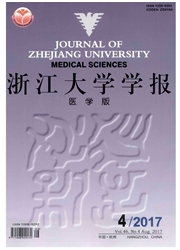

 中文摘要:
中文摘要:
目的:观察苏拉明对脓毒症小鼠肺组织和循环炎症反应的抑制作用,并初步探讨其相关分子生物学机制。方法:①体内实验:将24只雄性C57BL/6小鼠按数字表法分为苏拉明组和生理盐水组,苏拉明组给予静脉注射5mg/kg苏拉明预处理。生理盐水对照组给予等体积0.9%氯化钠溶液,30min后采用静脉注射5mg/kg脂多糖(LPS)建立脓毒症小鼠模型,检测不同时间点肺组织和外周血TNF.仅和IL-15水平。②体外实验:苏拉明或生理盐水预处理人单核细胞系THP-1细胞30min后,用100ng/mL LPS刺激建立脓毒症细胞模型,于不同时间点收集THP-1细胞,提取RNA,定量PCR检测TNF—α和IL-6表达水平,并分离细胞浆和细胞核蛋白,蛋白质印迹法检测核因子KB(NF-kB)活性。结果:LPS干预后小鼠肺和外周血TNF—α和IL-6水平增加,提示成功建立脓毒症小鼠模型。与生理盐水组比较,苏拉明干预脓毒症小鼠模型作用24h时小鼠肺组织及外周血TNF—α和IL-6的水平降低(均P〈0.01);而苏拉明作用72h时各组小鼠肺组织及外周血TNF-α和IL-15的水平差异无统计学意义(均P〉0.05)。体外实验结果显示:苏拉明预处理减少LPS刺激THP-1细胞后TNF-α和IL-6的表达水平(均P〈0.01),苏拉明预处理还减少LPS刺激30min、60min和90min后THP-1细胞NF-kB的活化水平(均P〈0.01)。结论:苏拉明可减轻小鼠全身及肺组织炎症反应,在对脓毒症肺损伤模型中具有保护作用,其炎症反应的调控可能与抑制脓毒症单核细胞的过度活化有关。
 英文摘要:
英文摘要:
Objective: To investigate the effect of suramin on inflammatory response in pulmonary tissue and peripheral blood in septic mice. Methods: Twenty-four male C57BL/6 mice were randomly divided into two groups, and suramin (5 mg/kg) or normal saline was intravenously injected 30 min before LPS (5 mg/kg ) infusion' respectively. The contents of TNF-α and IL-6 in pulmonary tissue and peripheral blood were detected by ELISA. Suramin or saline-pretreated human mononuclear THP-1 cells were treated with 100 ng/mL LPS in vitro. The expression of TNF-α and 1L-6 mRNA and the activity of NF-kB were analyzed by quantitative PCR and Western blotting at different time points after LPS treatment, respectively. Results: Compared with the saline group, the TNF-α and IL-6 levels in pulmonary tissue and peripheral blood were significantly reduced in suramin group at 24 h after LPS treatment ( all P 〈 0.01 ) ; while there was no significant difference at 72 h between two groups ( all P 〉 0.05 ). The expression of TNF-α, IL-6 mRNA and the activity of NF-kB was decreased in suramin group at different time points after LPS treatment. Conclusion: Suramin can protect LPS-induced acute lung injury through down-regulation of systemic and pulmonary pro-inflammatory factors, which may be associated with the inhibition of NF-kB activity.
 同期刊论文项目
同期刊论文项目
 同项目期刊论文
同项目期刊论文
 期刊信息
期刊信息
